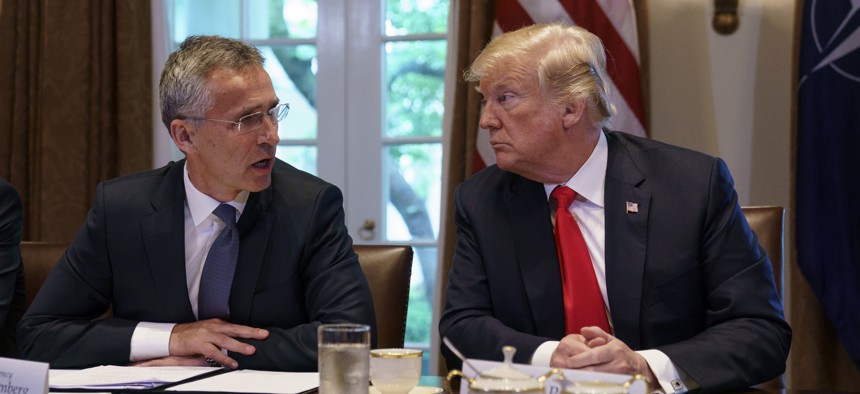
Carolyn Kaster/AP
Trump Touts Increased NATO Spending, But That Sort of Misses the Point, Experts Say
Experts say that the conversation’s been too focused on how much allies are putting toward defense, not on what they get for it.
As NATO Secretary General Jens Stoltenberg visited the White House Thursday, President Trump returned to a favorite talking point: how much the alliance’s other members are spending on defense.
By working with NATO, “we’ve increased and, really, raised a lot of money from countries that weren’t paying or weren’t paying a fair share,” Trump said. “We have a little ways to go, but many billions of dollars of additional money has been raised.”
Members of the North Atlantic Treaty Organization were already ramping up defense spending when Trump entered office, making good on a vow they took at their 2014 Wales summit in response to Russia’s annexation of Crimea.
Stoltenberg credited Trump with more recent increases, telling the president he “has had a real impact.”
But the conversation is beside the point for many in the transatlantic security community. Meeting the goal of spending 2 percent of a nation’s GDP on defense is important, but only if it means those dollars and euros strengthen NATO’s deterrence and build its security.
And to do that, the alliance really needs to bolster its “speed of assembly,” according to Ben Hodges, until recently the three-star commander of U.S. Army Europe. Right now, bureaucratic logjams, insufficient transportation infrastructure, and interoperability issues mean it could take NATO forces so long to get to a potential fight that it could be over before they arrived.
Fixing that doesn’t mean buying more tanks and fifth-generation fighter jets, says Hodges, now at the Center for European Policy Analysis. It’s time to expand NATO’s conception of “defense spending” to include the infrastructure it would take to push troops to the frontlines: heavy equipment transport (HET), rail access, storage, fuel, and other logistic necessities.
“I think the alliance should be smart, and take a look at what does 2 percent actually mean,” Hodges said in January, appearing at his first event as a civilian. “I agree 100 percent with that as a marker, but it has to be a little bit more sophisticated.”
Related: The US Should Embrace the EU’s New Defense-Cooperation Plan
Also read: NATO Needs to Step Up its Maritime Defenses
One more: European Battle Groups May Finally Get the Funding to Fight
“There are some countries that are 2-percenters, and 70 percent of that is spent on personnel costs, including pensions. I don’t know that that contributes necessarily to strong collective defense,” he added. “Seems to me, if a nation...spent money on rail networks, or provided HETs where you can carry tanks on their back, or expanded seaports that can receive and deploy more forces, if that helps them domestically, great, but if it has real military value for us the alliance, I think we ought to consider that toward their 2 percent.”
Even in uniform, he made similar points, calling for allies to make their spending meaningful.
"I'm not looking for more German tank battalions or more British artillery battalions. Countries are doing that," he told a Washington, D.C., audience last summer. “But ways that they can contribute to the alliance, improve infrastructure, improve freedom of movement and help provide ammunition."
Hodges might be the one beating the loudest drum, but he’s far from alone in saying the alliance’s thinking about defense spending should be expanded.
Ivo Daalder said there’s been a conversation about “outputs” — what you get for the money you put in — at least since he was the U.S. ambassador to the alliance from 2009 to 2013. It was part of the reason that delegates at the Wales summit outlined a target of spending 20 percent of defense dollars on major new equipment, the oft-overlooked younger goal standing just outside the spotlight on its 2-percent sibling.
It’s not that the U.S. and the rest of the alliance should forget about the 2 percent of GDP mark. “You need some measure,” and that’s the right one, says Daalder, now president of the Chicago Council.
“But I think we have spent too much time focusing on that 2 percent, and not enough time, not enough effort on what is that that 2 percent buys, number one, and two, what other steps are being taken to enhance interoperability, the ability to reinforce forces far forward,” he said. “What matters is not who’s spending 2 percent; what matters is can we defend the territory that may be attacked.”
But for all that the international security community might want to shift the conversation away from the 2 percent — or at least add new layers to it — it’s still likely to dominate the next NATO summit, to be held this July in Brussels. With U.S. administration officials in public and behind the scenes, burden-sharing is the name of the game.
“It is probably not the time to have that conversation” about complementary metrics, said Magnus Nordenman, who directs the Atlantic Council’s Transatlantic Security Initiative.
“The politics are blowing hot on both sides of the Atlantic when it comes to burden sharing,” Nordenman said. “So this may have to be an idea will have to continue to percolate for another year or two before it gets put on an agenda at a NATO summit.”
If it were to be meaningfully brought up, it could come down to the U.S. to lead that charge.
“But that means it’s not just about ‘You owe vast sums of money,’” Daalder said. “So it means moving on quite a bit from where the president of the United States has been for the last 18 months.”




